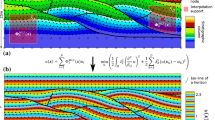Abstract
Deformable implicit surfaces, implemented with level set methods, have demonstrated a great potential in the computational sciences for applications such as modeling, simulation, and segmentation. They allow implicit handling of complex topologies deformed by operations where large changes can occur without destroying the level set representation. The use of level set techniques for the computation and segmentation of plane-like and high positive curvature features is nontrivial. We present a technique for representing and extracting fault surfaces from 3-D seismic attribute data such that 2-manifolds can be interactively computed and segmented. We present our approach as an interactive workflow that generates highly accurate fault surfaces.










Similar content being viewed by others
References
Dorn GA, James HE, Evins L, Marbach J, Coady FA (2007) Applications of Automatic Fault Extraction (AFE) in a Variety of Geologic Environments: Results, Limitations, and Suggested Improvements, AAPG Annual Meeting
Gowda CK, Krishna G (1978) Agglomerative clustering using the concept of nearest neighborhood. Pattern Recogn 10:105
Hutchinson S (1998) FZAP! Offers Automated Fault Picking, UserNet, 5 pages, May/June 1997 (printed Mar. 27, 1998)
Jain D, Dubes RC (1988) Algorithms for clustering data. Prentice-Hall Advanced Reference Series
Kadlec BJ, Dorn GA, Marbach J, Coady FA (2008) 3D Semi = Automated Fault Interpretation in CASI Using Evolving Surfaces, AAPG Annual Meeting, April 20–23
Kadlec BJ, Tufo HM (2008) A 3-D structure tensor approach to medial surface extraction and segmentation using level sets. Applications of partial differential equations in geometric design and imaging. VIIP
Lees JA (1999) Constructing faults from seed picks by voxel tracking: the leading edge, vol 18.3, March
Lohr T (2007) Seismic and sub-seismic deformation on different scales in the NW German Basin, Chap 4. Dissertation, FU-Berlin
Neff DB, Grismore JR, Lucas AW (2000) Automated seismic fault detection and picking, U.S. Patent Number 6,018,498
Osher S, Sethian JA (1988) Fronts propagating with curvature-dependent speed-algorithms based on Hamilton-Jacobi Formulations. J Comput Phys
Pedersen SI, Skov T, Randen T, Sonneland L (2005) Automatic fault extraction using artificial ants, mathematical methods and modeling in hydrocarbon exploration and production, Springer, Heidelberg
Pepper R, Bejarano G (2005) Advances in seismic fault interpretation automation, search and discovery article #40170
Suppe J (1985) Principles of structural geology, Prentice Hall, NJ, p 537
Twiss RJ, Moores EM (1992) Structural Geology. W·H. Freeman, San Francisco, p 532
Author information
Authors and Affiliations
Corresponding author
Rights and permissions
About this article
Cite this article
Kadlec, B.J., Dorn, G.A., Tufo, H.M. et al. Interactive 3-D computation of fault surfaces using level sets. Vis Geosci 13, 133–138 (2008). https://doi.org/10.1007/s10069-008-0016-9
Received:
Revised:
Accepted:
Published:
Issue Date:
DOI: https://doi.org/10.1007/s10069-008-0016-9




